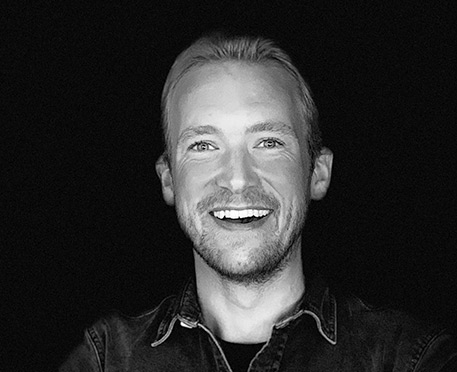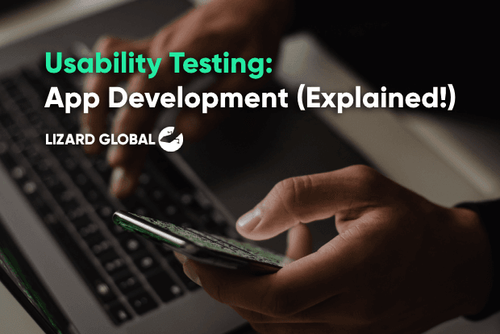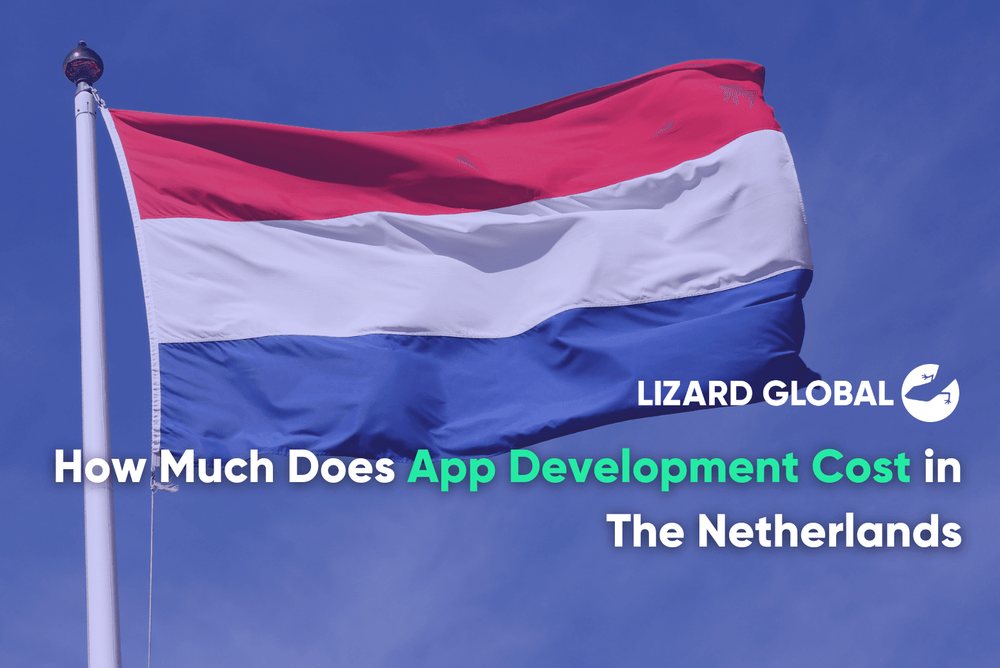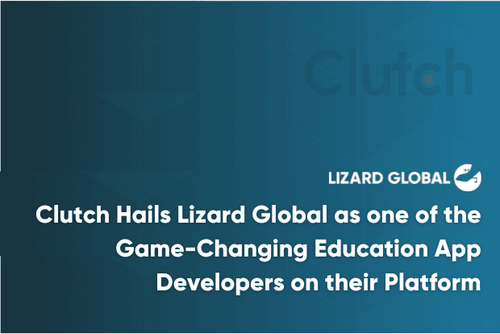Design Thinking: From Empathy to End-product
Get the latest updates about our blog posts.
Subscribe so you don’t miss out!
Follow Lizard Global on Facebook, Instagram, and LinkedIn.
Design thinking has been a central topic in several of our blogs, and deserves a place in the spotlight. While we mention Design Thinking a lot, we have never really gotten the chance to dive into the details, including why design thinking should form the cornerstone of all your business processes. This blog aims to answer all the lingering questions you still have about design thinking, what it is exactly and how you apply it to your business processes.
What is design thinking?
Design thinking is an ideology and a process of creative innovation that puts the main focus on the end-user and the way they perceive the interaction with a product or service. This way of thinking is very human-centered, and all decisions and actions are aimed at understanding the end-user’s ways of thinking, in order to deliver the best end-product possible.
“Design Thinking is a human-centered approach to innovation that draws from the designer’s toolkit to integrate the needs of people, the possibilities of technology, and the requirements for business cases.” - Tim Brown, CEO of IDEO
Although Tim Brown initially focused the concept on designers, design thinking isn’t exclusively focused on design processes in particular. Because design thinking is involved in all aspects of software development, everyone who is involved in these processes must orient their way of thinking and methodologies to the experience of the user. In the process of design thinking, you need to have the ability to look behind the walls of technical specifications and limitations, and inside the head of the end-user. What does the end-user want/need? What is their ideal vision of this product?
As a design thinker, you have to shift your focus from the project itself to the target audience of your product, and have a great sense of empathy and understanding of the individual mind. It’s design like we all know it, but with a hint of your non-cognitive skills to support you in the process. The practice of creating customer personas to identify and create a deeper understanding of your target audience segments is a typical example of a design thinking practice. The focus shifts to the end-user of your product, rather than the product itself. Because only by understanding exactly who your target audience is and what they need in order to optimize their user experience, can you create a product that satisfies all your users.

Customer-centric approach, empathy, and intuition
The success of your end-product relies on the extent to which your product is aligned with the needs of the people who are going to use it. All steps within the process of software development are executed from a customer’s perspective, rather than a company’s perspective. In order to be able to think like your target audience, you’ll need a special recipe of empathy and intuition. Empathy is crucial for understanding the end-user and materializing their needs into a sleek design and satisfying user experience. Next to that, intuition is essential for filling the gaps that remain after the input of your target audience. This intuition is based on your experience with similar projects in the past, your knowledge about (design) practices and their potential, and your own ability to provide valuable input, closely aligning with the vision of the end-user.
Design Thinking, Agile & Lean
Design thinking has a close connection with Agile methodologies and Lean Startup, as all these definitions focus on solving the problems end-users face when interacting with a product or service. The combination of Agile methodologies, a Lean mindset, and a design thinking approach results in a software development process in which the end-user is closely involved every step of the way. Lean Startup & Agile methodologies are iterative cycles of product development and test/feedback phases. During these iterative cycles, users are continuously stimulated to test out the product and return feedback for improvements. It is important that design thinking is interwoven in every step of the Lean Startup and Agile methodologies as the needs of the end-user can change as the product is created and improved upon. In order to deliver a product that is perfectly aligned with the end-problem, it’s essential to keep in close contact with your end-users and continuously emphatize with them.
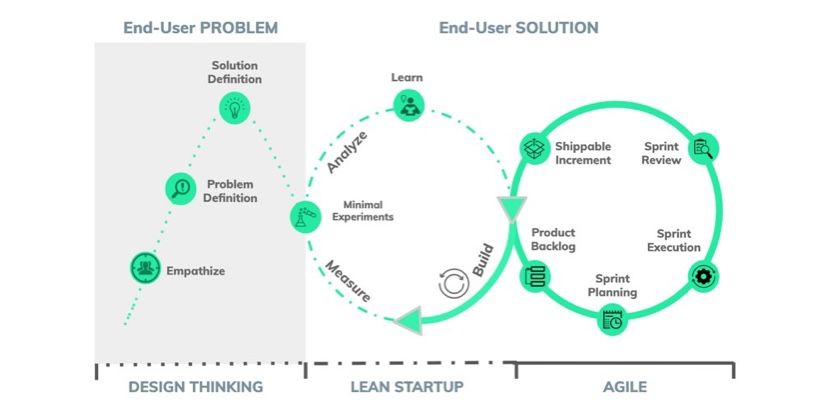
Applying a human-centered approach to the development process doesn’t only help companies to become more agile and flexible, it also greatly reduces time wasted on developing products that are not in line with the needs of the end-users anymore. At Lizard Global, we believe that a human-centered approach has the power to streamline all our processes, as well as the communications with the customers. By making the end-user our focus, we can create digital solutions truly that are perfectly tailored to solve the problems and needs of the user in a flexible and scalable manner.
The five phases in the design thinking process
The five phases involved in the process of design thinking form a crucial framework of trial and validation. That framework eventually provides the entire team involved in the process of product development with sufficient information to pick the right solution and create a viable end-product for the end-user, successfully competing with and staying ahead of possible competitors. Important to keep in mind is the fact that the separate stages of the design thinking process aren’t bound to a specific order. They are intertwined with other phases and are repeated iteratively. This is not a step-by-step manual you follow to reach an end-stage. Instead, the phases should be seen as different elements that contribute to the process of a project, rather than a leading guide.
Phase 1: Empathize & understand
The first stage entails a process of empathizing, in which a designer gets familiar with the target audience and market. This stage might be the most essential stage, as it builds the fundamentals of the end-product. This stage is also the most human-centered, as it focuses fully on the end-user, who they are, their needs, and their problems. This moment of, let’s call it brainstorming, revolves around the core skill of practicing empathy in design thinking: interviewing. You need a defined list of human-centered questions for your target group, in order to encapsulate their exact needs and wishes. Examples of questions like these are:
- What problem are we trying to solve, and is it truly a problem for you?
- Why do you need this app, and how would you use it?
- What tangible benefit will you receive from the app?
- Next to a few basic main features, are there features you envision adding in the future?
- How do you expect your target audience to behave within the app?
These sample questions are fully focused on the experience of the end-user of the product. Only when it’s clear why and how the product will be used by your target audience, can you begin formulating fitting solutions.
Phase 2: Market research
The second stage is the definition stage, in which you organise and conceptualise all information you have collected in the first stage. You want to find and define the problem, so you can start creating innovative problem-solving solutions. Next to the information you gathered based on the needs of your target audience, it’s also essential to look at your competitors in the form of extensive market research. It’s one thing to create an app that fits your end-users’ wishes, it’s another to make it stand out from existing competitors and make it more special and interesting than what’s already on the market.
Phase 3: Ideate, ideate, ideate
In the third stage of ideating, it’s up to you to come up with solutions based on your own intuition, experience, and skills. It’s the phase of filling in the gaps that got left behind after gathering input from the target market. If you’re on the right track, you have a clear image of what you are making, for whom, and how you’ll be making it. It’s now up to you to glue all that information together, and formulate a concrete step-by-step process towards your end-product. During this phase, all tasks are prioritized and ordered on the backlog. This helps to tie design thinking in with the agile development process. A handy tool to use during the ideation phase is the User Story Map, which captures the journey of the user and the interaction with the product. Besides creating a better understanding of the user experience, it also makes sure that the development team is on the same page during the development process, from the start to the iterative deployment of new releases.

Phase 4: Scale Down to an MVP
The fourth stage is all about prototyping. In other words, you create a scaled-down version of your end-product for your audience to try out. By now, you should have a clear image of how you want the product to look like, and how it’s supposed to function, based on your end-users’ input and your own intuitive additions and adaptations. A high-fidelity and interactive prototype must function in such a way it gives your target audience the opportunity to test it out like it is the actual finished product.
”Prototypes slow us down to speed us up. By taking the time to prototype our ideas, we avoid costly mistakes such as becoming too complex too early and sticking with a weak idea for too long.” - Tim Brown
Because a prototype often consists of a set of non-interactive mockups or a clickable demo, it doesn’t give end-users the full opportunity to interact with the application and is therefore limited in giving viable feedback. In order to provide the customer with a more realistic test product, we implement an MVP, or a minimum viable product. A minimum viable product is a product that has just enough features to satisfy its early users in order to receive viable feedback for future development implementations. The essence of an MVP is the delivery of a product with only the most essential features. Because by scaling down your product to a minimal set of features, you don’t only save time and effort, you also make sure that the product is continuously aligned with the needs of the end-user. Working towards an MVP fits perfectly within the mindset of Lean Startup and Agile methodologies, as prototyping and working towards an MVP are of an iterative nature, and are focused on continuous cycles of feedback and improvement before finalizing the development of a product.
- In short, an MVP can typically be described as:
- A bare-bones, functioning and market-ready product addressing its end-users’ core problem
- A method for gaining viable user feedback with the least effort possible
- A method that addresses a larger pool of users, gaining more valuable and realistic feedback than with a prototype
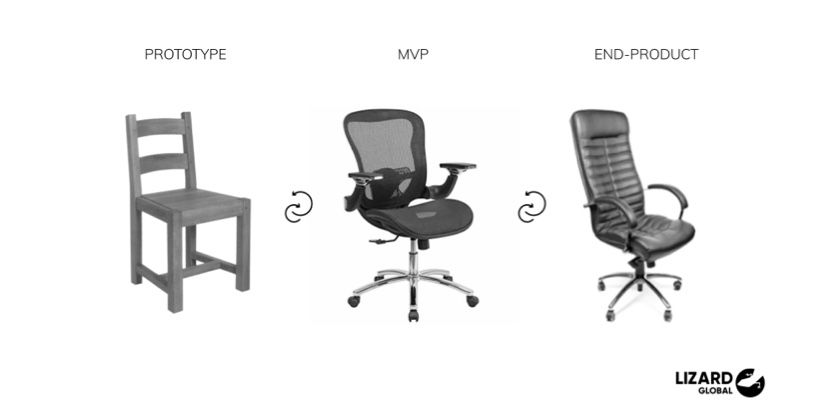
Phase 5: Iterative testing
In the last stage, the iterative test stage, you deliver the MVP and let your target audience make a test-ride. In order to receive viable and useful user-feedback, you’ll need a defined list of questions you want to have answered, focused on the functionalities of your prototype, and how users experience these functionalities. As with the entire concept of Agile and design thinking, prototyping isn’t a linear process. On the contrary, you and your end-users are very likely to continuously test new versions of the product and test out multiple features.
Even after defining and conceptualising a fitting solution, there’s always space for improvement. Building a product and utilizing design thinking is a constant process of iterative improvements and enhancements, like adjusting the design, adding new key features, or improving already existing features to make them more powerful and more aligned with the needs of your end-users. Once you have the validation of your users for the existing features, you can invest in more complex and advanced technologies, without the risk of having to begin from scratch if your users don’t like it. In the case of design thinking, but also growth hacking and other agile business strategies, failure is actually a good thing - but with design thinking and agile processes, you can learn from failure faster and often before a product feature is released fully to market.
This is exactly why this continuous improvement cycle is so important. Not only do you create a more precise image of the ideal end-product, you also raise the level of empathy and understanding with your end-user while going through this entire testing phase. Every obstacle within these phases will teach you more about how the end-user thinks, and vice versa. And that is precisely what you aim for within the process of design thinking.
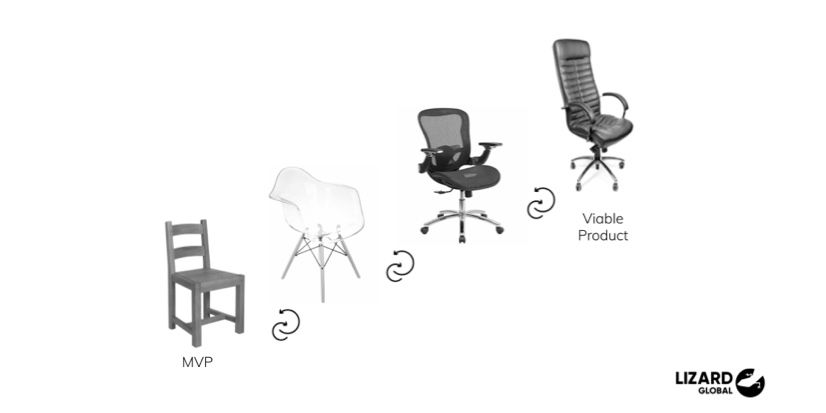
Design thinking at Lizard Global
Lizard Global is what they call a “Lean Startup” that implements the philosophy of design thinking by means of Agile methodologies, which means that all our processes are focused on creating value for our clients and end-users. Our way of working consists of two core elements: the end-user problem, and the end-user solution. Design thinking is the leading force behind defining the end-user problem and solution. As we explained in this blog, before we are able to define a fitting solution, we need to fully understand the problem. And to fully understand the problem, we have to empathize with our end-users. The process of defining the end-user problem therefore consists of three parts: empathizing by means of a human-centered approach, defining the problem based on the information we’ve gathered about the users and the issues they’re facing, and finally the definition of a tailored solution.

When we successfully pass the phase of defining the end-user problem with the methodology of design thinking, we begin the development of our defined solution. We do this by means of Agile Scrum Sprints, which consist of iterative cycles of developing, deploying, testing, and improving. We build an MVP, provide opportunities to test out our product, analyze the feedback of our end-users and improve the product where needed. Every Sprint is based on that iterative and Agile process towards a perfect end-product.
All the while as we develop the product, we use the practice of design thinking to achieve the best possible results. The concept of design thinking runs through our entire process of software development, from conceptualising an idea to designing and developing the product and guiding it onto the market. At Lizard Global, we involve every team member in our ideology of human-centered thinking and working. Our sales team, marketing team, product owners and project managers, UI/UX designers, and developers all highly value the input of our end-users in order to create the best innovative and sustainable solutions possible.
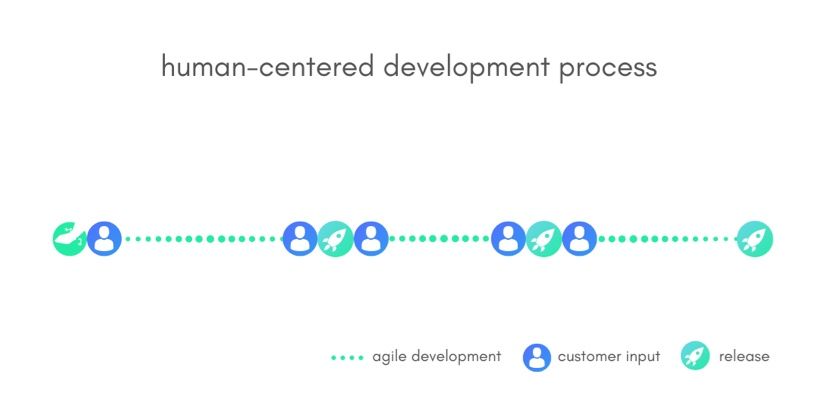
Do you want to know more about how we implement design thinking at Lizard Global? Or are you looking for a digital partner to help you with the development of your application, web-app, or website? Don’t hesitate to give us a call or fill in the contact form on our website. Follow us on Facebook, LinkedIn, and Instagram to stay up-do-date with our projects and new blogs!


